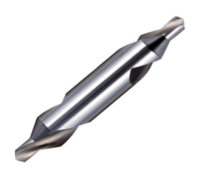Centre Drill: Difference between revisions
From DT Online
(Corrected Link) |
(Added Note) |
||
| Line 1: | Line 1: | ||
[[File:CentreDrill.png|200px|right]] | [[File:CentreDrill.png|200px|right]] | ||
Also known as '''Slocombe Drills''', [http://wiki.dtonline.org/index.php/File:CentreDrill.png '''Centre Drills'''] were originally designed to create the countersink required to locate a tailstock centre when turning between centres. They have a point angle of 60° to match the angle of a '''Tailstock Centre''' | |||
A [http://wiki.dtonline.org/index.php/File:CentreDrill.png '''Centre Drills'''] can also be used to provide a start location for a drill when drilling down the centre of a bar held in a '''[[Centre Lathe|Lathe]]''' '''chuck'''. '''Centre Drills''' are short and rigid enough to mark the bar centre without wandering off if they are carefully offered up to a rotating work-piece. Although their point angle does not match that a '''[[Twist Drills|Twist Drill]]''' only a small indentation is required, so for most work in '''[[Design and Technology]]''', this is not an issue. | |||
---- | |||
<span style="color: green">'''Note:''' | |||
Engineers may prefer a [https://en.wikipedia.org/wiki/Drill_bit#Center_and_spotting_drill_bits '''Spot Drill'''] which is a short stubby drill designed specifically for this purpose. Alternatively, a small indentation can be cut in the bar centre with a sharp lathe tool. | |||
</span> | |||
---- | |||
[[Category:Drilling and Boring]] | [[Category:Drilling and Boring]] | ||
Revision as of 10:05, 24 April 2016
Also known as Slocombe Drills, Centre Drills were originally designed to create the countersink required to locate a tailstock centre when turning between centres. They have a point angle of 60° to match the angle of a Tailstock Centre
A Centre Drills can also be used to provide a start location for a drill when drilling down the centre of a bar held in a Lathe chuck. Centre Drills are short and rigid enough to mark the bar centre without wandering off if they are carefully offered up to a rotating work-piece. Although their point angle does not match that a Twist Drill only a small indentation is required, so for most work in Design and Technology, this is not an issue.
Note: Engineers may prefer a Spot Drill which is a short stubby drill designed specifically for this purpose. Alternatively, a small indentation can be cut in the bar centre with a sharp lathe tool.
